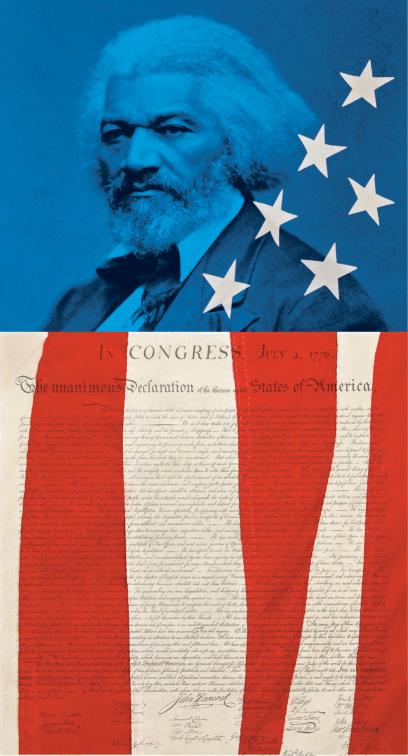As our country celebrates the 4th of July, this is an opportune time for students to reflect on America’s past and consider how we can live up to our ideals of equality and opportunity. With President Biden striving for this year’s July 4th holiday to be a turning point in our fight against COVID-19, and with the American Rescue Plan Act delivering desperately needed funds to families and local and state governments, let’s think carefully about the America we want to build together. Here, we highlight materials available through Share My Lesson to help students understand America’s fight for freedom and carry that fight into the future.
Analyzing the Declaration of Independence
Crucial to any study of America’s aspirations is the Declaration of Independence. See “The Revolutionary Declaration of Independence,” a 90-minute lesson plan created by Share My Lesson partner ConSource, to engage high school students in a close reading of the declaration and to help them understand the colonists’ vision for a new form of government. Students discuss this challenging question: “Is the Declaration of Independence a positive statement of rights, or is it instead simply a response to British tyranny?”
For high school students who need additional assistance, particularly with behavior, check out “The American Revolution.” Created by the Cincinnati Federation of Teachers (CFT), this four-week lesson plan supports the Managing Behavior in School Communities professional learning course created by the AFT and offered by CFT. Using primary sources, students learn about the European countries that explored and colonized North America and the road to American independence.
For students in grades 11–12 who are ready for a less scaffolded approach, Share My Lesson partner What So Proudly We Hail offers “A Lesson on the Declaration of Independence.” Designed for a 60-minute class period, the lesson was created by a high school history teacher and challenges students with a series of questions to analyze the document’s structure and meaning. Extension activities include reading Thomas Jefferson’s letter to Henry Lee, which explains the declaration’s purpose and principles, and writing essays.
Fulfilling the Promise of Freedom for All
Despite freedom rhetoric, many people in America were not free. A lesson for grades 11–12 that examines this point is “What to the Slave Is the Fourth of July?,” which takes its name from an address that Frederick Douglass, the abolitionist leader who escaped enslavement, gave on July 5, 1852. Created by the National Humanities Center, a Share My Lesson partner, the lesson explores the address, in which Douglass compares the abolitionists of his time with the patriots of 1776.
To introduce middle and high school students to Douglass’s speech, and for two resources that relate his words to present-day America, see “Protest Is Patriotic,” by Share My Lesson partner Learning for Justice. Published in June 2020 during intense protests against systemic racism and police brutality, the post shows how the July 4th “holiday and its symbols are tied to a long tradition of protest and demands that our nation make good on its promise of freedom for all.”
A resource delving into protest with students in kindergarten through third grade comes from Share My Lesson partner the Anti-Defamation League. Its discussion guide for Enough!: 20 Protesters Who Changed America, a picture book by Emily Easton, helps children learn about an array of American leaders devoted to freedom. Among those featured are Samuel Adams, a signer of the Declaration of Independence, and Harriet Tubman, who led many enslaved people to their freedom.
Finally, Get to Know Bernardo de Gálvez, by Guillermo Fesser, tells the story of a Spanish general who was critical to helping the patriots win the Revolutionary War. Available in English and Spanish, this book for upper elementary students highlights the role that Hispanic people played in creating this country.
For more Share My Lesson resources on Independence Day, see the collection here. If you have additional ideas or requests, please reach out to us at content@sharemylesson.com.
–THE SHARE MY LESSON TEAM

